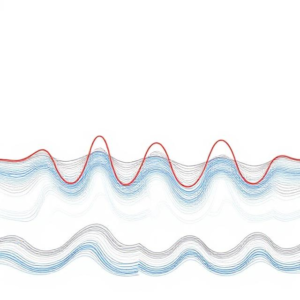Sound Waves:
Sound is a form of energy that travels through a medium, like air, water, or solid objects. It’s made up of vibrations that move through the air or other substances, creating what we call sound waves.

How sound waves work:
- Vibrations: Imagine a bell ringing. When the bell rings, it vibrates. These vibrations push and pull on the air molecules around the bell.
- Compression and Rarefaction: As the bell vibrates, it creates areas where the air molecules are pushed close together (this is called compression), and areas where they are spread out (this is called rarefaction). These compressions and rarefactions move through the air in waves.
So, sound waves are pressure waves moving through the air. The speed and quality of sound depend on the medium it’s traveling through (sound moves faster in water than in air, and faster in solid objects like metal than in liquids).
Important Properties of Sound Waves:
- Frequency: How many times the sound wave vibrates in one second. This is measured in Hertz (Hz). A higher frequency means a higher pitch (like a high-pitched whistle), and a lower frequency means a lower pitch (like a bass drum).
- Amplitude: How big the sound wave is, which determines the loudness of the sound. A bigger wave (larger amplitude) means the sound is louder.
- Wavelength: The distance between two crests (the highest point) or troughs (the lowest point) of the wave. Longer wavelengths usually produce lower-pitched sounds, while shorter wavelengths produce higher-pitched sounds.
Doppler Effect:
The Doppler Effect is the change in the frequency (or pitch) of a sound as the source of the sound moves relative to the observer. It explains why a car engine sounds different when it’s coming toward you compared to when it’s moving away from you.
Here’s how it works:
- When the sound source is moving toward you: As the object moves toward you, the sound waves get compressed. The waves have less time to spread out between the source and you, so they arrive at a higher frequency. This makes the sound pitch higher.Example: When an ambulance is coming toward you, the siren sounds higher-pitched.
- When the sound source is moving away from you: As the object moves away, the sound waves get stretched out. The waves have more time between them before they reach you, so they arrive at a lower frequency. This makes the sound pitch lower.Example: When the ambulance passes and moves away, the siren sounds lower-pitched.
Real-Life Example:
Imagine a car moving past you while honking its horn. As the car approaches, the horn’s sound seems higher-pitched. As it moves away, the pitch of the horn drops. This change in pitch is the Doppler Effect in action.
Why does this happen?
It’s all about how the moving sound source changes the way the sound waves are spaced out. When the source is moving towards you, the sound waves bunch up, causing a higher frequency (higher pitch). When the source moves away, the waves stretch out, causing a lower frequency (lower pitch).
Summary:
- Sound waves are vibrations that travel through air or other materials.
- The Doppler Effect happens when a sound source moves toward or away from you, causing the pitch to change: higher when moving toward you, lower when moving away from you.











